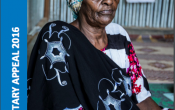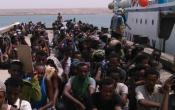Djibouti
Operation: Djibouti
Location
{"longitude":42,"latitude":12,"zoom_level":7}
Latest update of camps and office locations 13 Jan 2016. By clicking on the icons on the map, additional information is displayed.
Key Figures
| 2015 end-year results | |
| 100% | of people of concern under UNHCR’s care and maintenance programme were registered |
| 100% | of people of concern had access to health care services in the camps, as well as to public hospitals through referrals. |
| 97% | of people of concern were immunized against measles, and the rate of global acute malnutrition fell from about 18 per cent in 2014 to 11 per cent in 2015 |
| 2,950 | refugee children of primary school age (88 per cent) were enrolled in school |
| 16 | litres of potable water available in camps per person per day on average |
| 2016 planning figures | |
| 100% | extent to which the law is consistent with international standards relating to refugees |
| 30 | average number of days from first instance interview to notification of decision (refugee status determination) |
| 100% | of people of concern have a birth certificate |
| 60% | of people of concern with own business or self-employed for more than 12 months |
| 100% | of people of concern assisted with their basic needs |
Latest Updates and Related Links
People of Concern
10%
Decrease in
2015
2015
| 2015 | 22,006 |
| 2014 | 24,362 |
| 2013 | 23,810 |

[["Refugees",19365],["Asylum-seekers",2641]]
Loading ...
Budgets and Expenditure for Djibouti
< Back
2015
{"categories":[2012,2013,2014,2015,2016],"budget":[26.92291952,26.23853782,26.95790235,41.39620267,31.98783036],"expenditure":[8.19790231,7.57613705,7.38017953,10.5087068,null]}
{"categories":[2012,2013,2014,2015,2016],"p1":[26.92291952,26.23853782,26.95790235,41.39620267,31.98783036],"p2":[null,null,null,null,null],"p3":[null,null,null,null,null],"p4":[null,null,null,null,null]}
{"categories":[2012,2013,2014,2015,2016],"p1":[8.19790231,7.57613705,7.38017953,10.5087068,null],"p2":[null,null,null,null,null],"p3":[null,null,null,null,null],"p4":[null,null,null,null,null]}
Loading ...
CHOOSE A YEAR
- 2015
- 2016
Working environment
- Despite political stability and economic growth, Djibouti faced high poverty and unemployment rates in 2015.
- The operational context was marked by a massive influx of refugees and migrants, which was triggered by the crisis in Yemen. Social services, natural resources and economic assets were subsequently overstretched.
- The country had no permanent surface water source, no more than 0.05 per cent of arable land, non-mechanized agriculture, and harsh weather conditions, which all contributed to the population’s vulnerability.
Population trends
- At the beginning of 2015, the total number of persons of concern to UNHCR in Djibouti was some 15,000. Because of the outbreak of the Yemeni crisis, an additional 6,400 refugees entered the country in 2015.
- By the end of the year, there were a total of 22,000 persons of concern in Djibouti, including some 19,000 refugees and 3,000 asylum-seekers.
- Some 64 per cent of refugees were from Somalia, 32 per cent from Yemen, some 3 per cent from Ethiopia, and 2 per cent from Eritrea. As for asylum-seekers, 73 per cent were from Ethiopia, 25 per cent from Eritrea and some 2 per cent from Somalia.
Achievements and impact
- Registration data was updated, and mechanisms for the continual updating of data were put in place.
- In December 2015, the President of the National Eligibility Commission established an ad hoc committee to finalize the review of a national refugee bill, which UNHCR helped to initiate.
- After its activities resumed, the National Eligibility Commission held 8 sessions during which refugee status was granted to 49 out of 96 asylum-seekers whose files were under consideration (51 per cent recognition rate).
- UNHCR promoted good practices in infant and young child feeding with the support of health and nutrition promoters and health care staff, including through awareness-raising, community engagement and breastfeeding-friendly spaces. Efforts were made to stock ready-to-use therapeutic food and premix to prevent frequent interruptions in their provision.
- In line with UNHCR’s Education Strategy, children in kindergarten were taught in French in accordance with the Djiboutian curriculum, initiating the transition from the Kenyan curriculum. The aim was to gradually scale-up the transition through each grade level.
- The quantity of water available per person in Holl Holl camp was within acceptable standards.
Unmet needs
- Additional classes and latrines were needed as schools operated in two shifts, classrooms were overcrowded and latrines were full.
- The provision of durable shelter for all refugees in camps was needed, because the majority was still living in inadequate shelters, despite having lived in the camps for more than two decades. Alternative sources of energy for cooking and lighting were also required, and durable family latrines should have replaced traditional latrines.
- Despite some improvements, the rate of malnutrition did not meet acceptable standards.
- The quantity of water available per person in Ali Addeh camp was not within acceptable standards.
Working environment
Long considered an example of stability in a volatile region, Djibouti is now facing a precarious security situation. The country plays a significant role in international efforts to combat piracy in the region, and supports the restoration of peace in Somalia; however these efforts have led to threats of reprisal attacks.The country has limited natural resources and is struggling to recover from the continuous drought of recent years. Djibouti has a high national unemployment rate, placing further economic pressure on the population. Work opportunities and prospects for refugees’ local integration are scarce: this affects livelihood opportunities.
Djibouti continues to deal with a protracted refugee crisis, having hosted more than 23,000 mainly Somali refugees, in many cases for more than two decades, in the Ali Addeh and Holl Holl refugee camps.
Its geographic location, environmental conditions, and regional socio-economic and security situation mean Djibouti has increasingly become a transit country for mixed migratory movements to other countries such as Yemen, and beyond to the Gulf States and Europe.
In 2015, UNHCR will continue to count on the hospitality and support extended to refugees and asylum-seekers by the Djibouti Government, including the provision of land for the two refugee camps. The Office National d’Assistance aux Réfugiés et Sinistrés (ONARS) will manage water, food distribution and security.
Needs and strategies
In 2015, UNHCR will protect and assist more than 28,000 people in Djibouti who are seeking asylum from insecurity and oppression in neighbouring countries. The Office will continue to research the most appropriate durable solutions for the population of concern in a protracted situation – developed in coordination with partners, the Government and the communities themselves – to address their needs.Based on the results of physical verification and a household socio-economic assessment of refugees, which is planned for the end of 2014, UNHCR is likely to reorient its programme towards the search for durable solutions.
The Office and its main partners will place greater focus on self-reliance activities in Djibouti, while continuing to work on improving the operational context in the country. Building on work undertaken in 2014, activities in 2015 will focus on: health/nutrition, water, education and self-reliance/livelihood activities, sexual and gender-based violence (SGBV), and durable solutions. For people in a protracted situation, UNHCR will enhance access to self-reliance and livelihood activities to help reduce their dependency on assistance.





